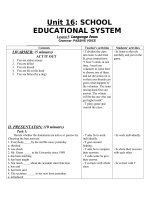Unit 13 Language Focus Grade 10
Bạn đang xem bản rút gọn của tài liệu. Xem và tải ngay bản đầy đủ của tài liệu tại đây (99.71 KB, 4 trang )
Unit 13: Films and Cinema- Language Focus
Unit 13: Films and cinema
Part E: Language focus
Planning date: 20/03/2010
I. Objectives
By the end of the lesson, students will be able to:
- Distinguish the sound /f/ and /v/.
- Pronounce the words and sentences containing these sounds correctly.
- Distinguish two kinds of adjectives of attitude: past participe and present participle.
- Use adjectives of attitude to describe films or to express their opinion about
particular films.
-
II. Anticipated problems.
1. Problems.
- Students may have difficulty in pronouncing two sounds /f/ and /v/
- Students namay confuse the use of past participle and present participle.
- Students may forget grammatical structure or vocabulary so it’s difficult for them to
express their opinion about a film.
- Studentd may feel uninteresting in the lesson.
- Some timid students don’t take part in the lesson.
2. Solutions
- Teacher should let students to practise two sounds /f/ and /v/ many times and ask
them to repeat them.
- Teacher should explain the use of adjectives of attitude clearly and ask students to do
many exercises.
- Teacher should remind students of some old structures which related to this lesson:
find + S + adjective.
- Encourage timid students to take part in the lesson.
- Give more exercises for students to practise.
III. Procedures
Teacher’s activities Students’activities
I .Warm- up (5minutes)
- Teacher writes two sounds /f/ and /v/ on the board.
- Asks two students to go to the board and write words
beginning with /f/ and /v/.
- One students writes words beginning with /f/.
- One students writes words beginning with /v/.
- Encourages them write as many as they possible.
- Listen to the tacher.
- Go to the board and write
words beginning with /f/
and/v/.
- Read these words aloud.
Designed by Le Thi Dung
Unit 13: Films and Cinema- Language Focus
- The winner is the person who can write more words.
- Asks 2 students to read the words they have written.
II. Pronunciation (10 minutes)
Distinguish sounds /f/ and /v/.
- Turns on the radio and asks students to listen to
sounds twice or three times.
- Asks students to repeat following the radio.
- Students practise pronouncing the sounds in
chorus for a few more times.
- Calls on some students to read the words out loud.
- Corrects if students pronounce the target words
incorrectly.
Practice sentences containing the target
sounds.
- Turns on the radio.
- Asks students to listen and underline the words
with the sounds and write /f/ or /v/ under them.
- Asks students to practise these sentences in pairs.
- Asks some students to read the sentences out loud.
- Corrects if they pronounce incorrectly.
- Listen to the teacher.
- Repeat these sounds
- Practise these sounds in
chorus and individually.
- Listen to the radio.
- Underline the words with
the sound and write /f/
or /v/ under them.
- Practise in pairs.
- Read out the sentences.
IV. Grammar
1. Presentation (5 minutes)
- Gives 3 examples:
1. The film is so boring.
I’m bored with that film.
2. Mary thinks English is very interesting.
Mary is very interested in learning English.
3. The cartoon “ Tom and Jerry” is exciting.
I am excited in the cartoon
- Explain the underlined words in each sentences.
The – ing form has an active meaning
The – ed form has a passive meaning (how
people feel)
- Asks students to give some ther examples.
- Checks their examples.
- Asks students to do 2 tasks in the textbook.
2.Practice (15 minutes)
- Listen to the teacher.
- Write down on the
notebook.
- Give some examples.
Designed by Le Thi Dung
Unit 13: Films and Cinema- Language Focus
Exercise 1: Write the adjectival form of the verbs.
- Teacher writes the adjectival form of one verb as
example.
- Asks students to do exercise 1 individually.
- Goes arround to provide help.
- Calls n some student to go to th board and write
their answers.
- Checks their answer and give the correct ones.
Correct answer:
1 fascinating - fascinated
2 terrifying - terrified
3 irritating - irritated
4 surprising - surprised
5 horrifying- horrified
6 frustrating- frustrated
7
Exercise 2
- Introducse the exercise and asks students to read
all the sentence through.
- Explain the new words if any.
- Gets students to do the exercise individually and
goes arround checking that they work.
- Calls on 5 students t go to the board and write
their answers.
- Checks with the whole class and provides correct
answers.
Correct answer;
1. a. depressing b. depressed
2. a. interested b. interesting
3.a. boring b.bored
4.a excited b.exciting
5.a exhausting b. exhausted
3. Production (8 minutes)
Write the sentences.
- Gives some picture of some famous films.
- Asks studens to decide which kind of films they
belong to.
- With each ilm, give one adjective of attitude to
describe it.
1. Cartoon/ exciting/ excited
2. comedy/ amusi ng/ amused.
3. Detective film/ thrilling/ thrilled.
- Work individually and do
exercise 1.
- Write the answer on the
board.
- Check their answers.
- Write the correct answers
down on the notebook.
- Work individually.
- Do exercise 2.
- Write their answers on
the board.
- Check their answers.
- Listen to the teacher.
- Decide which kind of films
the films belong to.
- Write the sentence using
the cues.
- Read out their answers.
- Check their answers.
Designed by Le Thi Dung
Unit 13: Films and Cinema- Language Focus
4. Love story film/ moving/ moved.
5. Horror film/ terrifying/ terrified.
- Asks students to write the sentences using the
cues.
- Goes around to provide help.
- Calls on 5 students to read their answers.
- Checks their answers and gives correct ones.
1. The cartoon is exciting. I’m excited about it.
2. The comedy film is amusing.
I am amused by the comedy film.
3. The detective film is thrilling.
I am thrilled by the detective film.
4. The love story film is moving.
I am moved by the love story film.
5. The horror film is terrifying.
I am terrified by the horror film.
V. Homework (2 minutes)
- Teacher summarise the main points.
- At home, review the attitudinal adjectives.
- Listen and take note.
Designed by Le Thi Dung









